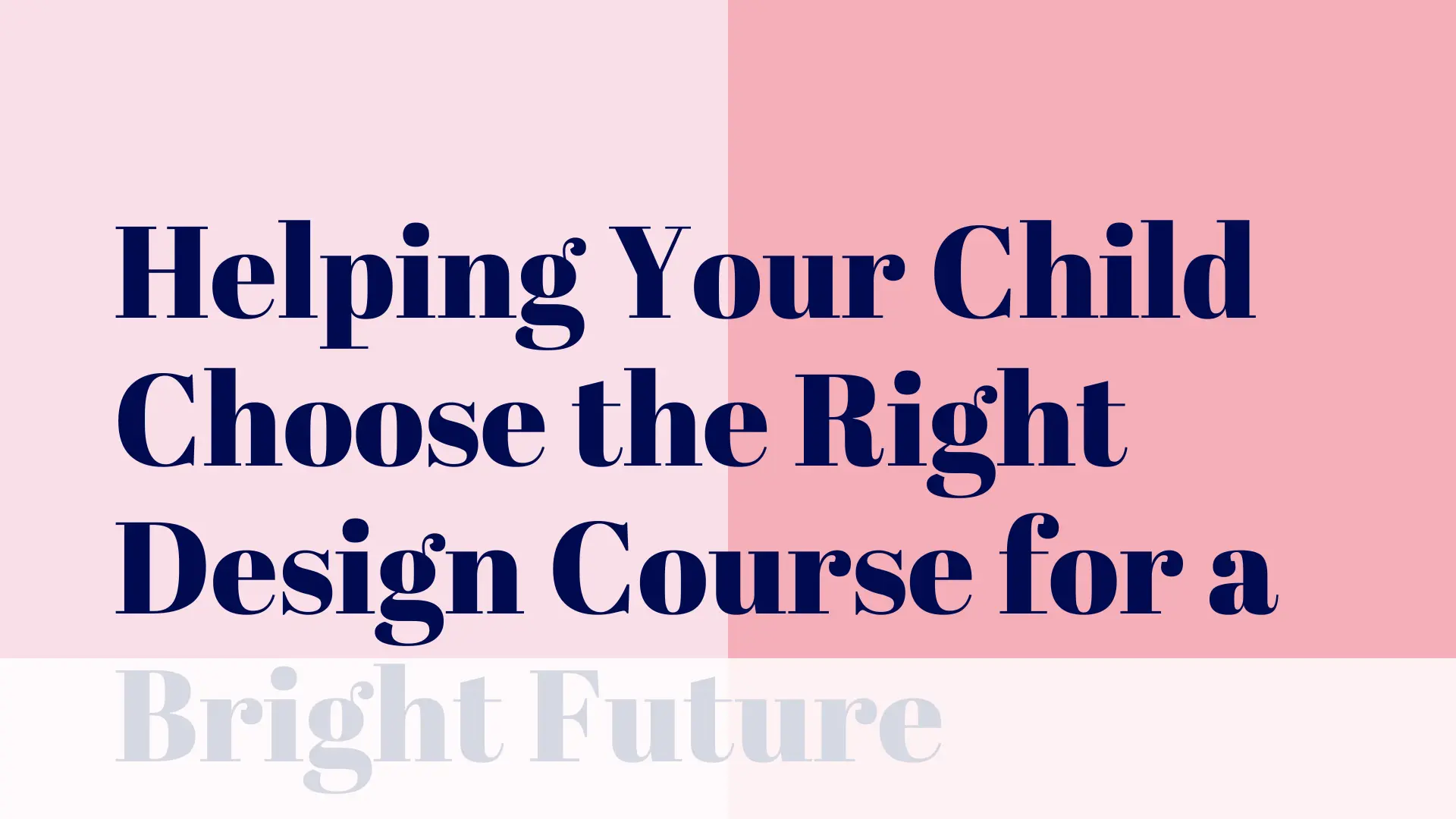Unlocking Your Child's Creative Potential: Navigating the World of Design Courses
So, child your has a spark .A passion for creating innovating ,and bringing beautiful things into the world. Maybe they're constantly sketching building elaborate LEGO structures , or crafting digital masterpieces on their tablet.You see their potential ,that vibrant future brimming with creative energy and you want to help them nurture it.But the world of design education can feel overwhelming.Where do you even begin?This blog post is your compass guiding you through the exciting landscape of design courses and helping you choose the perfect path for your child's unique talents .
What Design Discipline is the Right Fit for My Child's Personality ?
Choosing the right design course isn't just about picking a pretty picture; it's about aligning your child's personality interests and with a specific design discipline . Think of it like finding the perfect instrument for a budding musician – a violin might be ideal for one child while a drum kit perfectly suits another.
The Analytical Architect: Graphic Design, UX/UI Design
Does your child possess a keen eye for detail a love for problem-solving and a knack for organizing information?They might thrive in fields like graphic design or UX/UI design . Graphic designers visual create concepts for everything from logos and websites to marketing materials . UX/designers UI focus on user experience creating intuitive and engaging interfaces for websites and apps. These roles demand both creativity and a meticulous approach, making them perfect for analytical thinkers.
The Visionary Storyteller: Animation Illustration, Game Design
If your child is captivated by narratives, characters, and the power of visual storytelling animation illustration ,or game design could be the ideal fit. Animators bring characters to life illustrators create compelling visuals for books and other media and game designers craft immersive interactive experiences. These fields require strong storytelling skills combined with artistic talent. Remember that success in these fields often requires strong programming knowledge in addition to creative talents.
The Hands-On Creator: Fashion Design, Product Design,Industrial Design
For the child who enjoys tangible creation exploring the world of fashion product or industrial design might be the perfect choice. Fashion designers create clothing and accessories, product designers develop everyday we items use , industrial and designers focus on the form and function of manufactured goods. These fields demand both artistic vision and practical skills in material handling and production processes.
The Digital Maestro: Web Design and Development,Motion Graphics
In our increasingly digital world skills in web design and development or motion graphics are incredibly valuable.Web designers create visually appealing and functional websites while motion graphic designers use animation and visual effects to engaging create videos and other digital content . These fields blend artistic flair with technical proficiency,demanding a proficiency in software such as Adobe Creative Suite and others .
Is a Formal Education Necessary or Can I Teach My Child at Home?
This is a question many parents grapple with and the answer depends on largely your child's learning style ,your available resources and their long-term career goals.
Formal education offers structured learning access to specialized equipment and software ,and opportunities for networking with peers and industry professionals . A good design school or college provides a deep dive into design theory history and practice equipping students with a comprehensive skillset. Think of it as a curated apprenticeship, combining theory and practice.
Homeschooling or supplementing formal education with home-based activities can be a valuable complement to formal training. It allows for personalized instruction, focusing on your child's unique and interests learning pace. There are countless online resources – courses, tutorials and communities – that can support your efforts. However, consider the potential limitations in access to specialized equipment , mentorship, and professional networking opportunities .Perhaps the best approach involves a blend of both using home-based projects to reinforce and expand on what your child learns in a formal setting .
Remember , the goal is to find a that balance caters to your child’s specific needs and learning style.
How Can I Help My Child Explore Different Design Paths Before Committing ?
Before making a significant investment in a design course, it’s crucial to allow your child to explore different avenues. Think of this as a "design tasting menu" – a chance to sample various disciplines and discover their true passion.
Hands-On Exploration
Consider enrolling your child in workshops or summer programs that offer introductory courses in various design fields.These shorter programs provide a low-pressure environment to experiment and discover their strengths and preferences .Many art museums and community centers offer these types of activities .
Self-Directed Projects
Encourage your child to undertake independent projects related to different design areas. For instance, they could design a logo for a fictional company create a short animated film or design a product that solves a specific problem.These self-initiated projects provide a valuable insight into their creative process and problem-solving abilities.
Mentorship and Shadowing
Connecting your child with working professionals in different design fields is invaluable.A brief shadowing experience or a mentorship opportunity can offer an inside look at the daily realities of various design careers and further inform their decision.
Online Resources and Portfolios
Explore online resources like Skillshare,Coursera , and Udemy for introductory design courses and tutorials. Encourage your child to create an online portfolio to showcase their work even if it's just a collection of early experiments .This digital footprint will be valuable as they progress in their design journey.
What Skills I Should Look for in a Good Design Course?
The ideal design course should go beyond simply teaching software skills. Look for programs that cultivate a holistic approach to design nurturing creativity ,critical thinking and effective communication.
Strong Foundation in Design Principles
The curriculum should cover design fundamental principles such as composition color theory, typography , and visual hierarchy . A good understanding of these principles provides a solid base for any design discipline.
Practical Application & Project-Based Learning
Look for programs that emphasize hands-on experience through project-based learning .This approach allows students to apply theoretical knowledge to real-world scenarios enhancing their problem-solving skills .
Industry-Relevant Software
The course should incorporate industry-standard software relevant to the chosen design field . Proficiency in these tools is essential for a successful design career.
Mentorship & Feedback
Effective feedback from instructors and peers is critical for growth. A strong mentorship program provides students with personalized guidance and support throughout their learning journey .
Networking Opportunities
Consider the opportunities the course provides for networking with industry professionals .Connections made during the program can lead to internships job opportunities and valuable mentorship relationships.
Beyond the Classroom: Building a Successful Design Career
A successful design career requires more than just talent and technical skills. It demands strong a ethic work passion a for continuous learning and ability the to adapt to the ever-evolving landscape of the design industry .
Building a Strong Portfolio
compelling A portfolio is essential for showcasing your child's skills experience and to potential employers. Encourage them to continuously update their portfolio with their best work, highlighting their unique style and abilities.
Networking and Collaboration
Networking is crucial for any design professional . your Encourage child to attend industry events, connect with professionals online and actively seek out collaboration opportunities.
Continuous Learning and Adaptability
The design world is constantly evolving,so continuous learning is vital for career growth.Encourage your child to stay abreast of emerging technologies and design trends through workshops,online courses and industry publications.
Choosing the right design is course significant a decision ,but by carefully considering your child’s personality, exploring different avenues,and selecting a program that emphasizes both theory practice and you can set them on a path towards a fulfilling and successful in career the vibrant world of design . Remember , the journey is as important as the destination; support your child's creative spirit, and watch their talents flourish!


